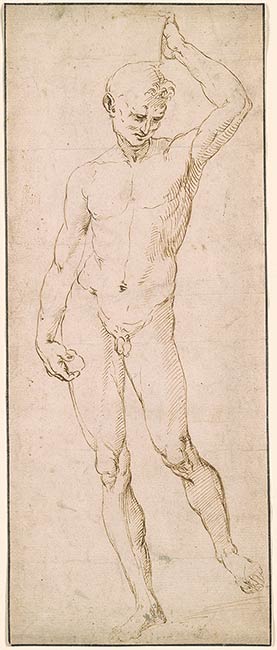
Raphael’s prodigious natural talent as a draftsman surely contributed to his precocious success—as in Pinturicchio’s decision to employ Raphael as a designer of scenes for the Piccolomini Library in Siena (see 1996.9)—but a distinct aspect of the young artist’s genius was his ability to assimilate influences from a range of sources both as he moved between regions and also as new works appeared from his contemporaries (on this subject, see also I, 15). His style thus developed rapidly as he moved from Urbino to Umbria to Florence and finally to Rome. The elegantly sweet if somewhat weightless figures that he learned from Perugino gave way in his drawings of around 1502 to more robust figures studied from Signorelli’s works.1 We can also trace in Raphael’s drawings the effect of his arrival in Florence, when he began to study sculptural form as never before, in sheets such as the Four Standing Soldiers at the Ashmolean, in which the central figure is based on Donatello’s St. George at Orsanmichele.2
One can thus imagine the impact on Raphael of the unveiling of Michelangelo’s David in September of 1504. A group of drawings bears testament to his response. The best known of these is a study at the British Museum of the sculpture seen from behind (inv. Pp,1.68). Not only the pose but also the tree stump behind the figure’s legs (a necessary element for the stability of the marble original) make the source obvious. As Ben Thomas has recently noted, however, the sketch is evidently drawn from memory or at least is not an attempt at a perfect copy of the model, for Raphael corrected the statue’s proportions and rotated the shoulders and torso.3 A drawing in the Ashmolean, in turn, begins as a frontal view of the David, but in that sheet Raphael shifted the positions of the arms to have the figure instead hold a spear and shield.4 The Morgan drawing is yet another iteration of the David, again adopting a frontal view but shifting the figure’s proper left arm upward so that rather than holding the sling, he becomes a canephore, supporting a basket on his head. This practice of drawing from a notable work of art but shifting its position or iconographic function is one that would later be practiced by Raphael’s own pupils, for example by Cesare da Sesto during his years in the Raphael workshop (see II, 26-II, 66).
The Morgan’s Standing Man has been largely overlooked in modern Raphael scholarship. Long dismissed as a copy of a lost drawing by Raphael, the sheet was first rehabilitated by John Gere in 1987, who argued that features like the drawing of the head, the shape of the hands and fingers, and the structure of the knees all pointed to it being the original. Gere, however, dated the sheet to the early Umbrian period, “probably before 1500.”5 In a review of Gere’s exhibition catalogue, David Rosand endorsed the attribution to the master,6 and in 1994 Linda Wolk-Simon again published the drawing as by Raphael.7 The work has gone virtually unmentioned by scholars since, although during his recent tenure as the Thaw Senior Fellow at the Morgan Drawing Institute, Nicholas Penny also argued in favor of the attribution and noted that the work deserved more attention.
In first noting that the source for the Morgan figure was the David, Wolk-Simon advanced the date of its creation to around 1504. She argued that this “appears to be [Raphael’s] earliest drawing inspired by the David.”8 The differences in the hatching between the Morgan sheet and the British Museum study or the various above-mentioned drawings at the Ashmolean, however, argue for a slightly later date, perhaps closer to the end of Raphael’s Florentine period. In the years 1505–7, that is, Raphael seems to have tended toward the sparer hatching seen here, with its straighter and more widely spaced parallel lines for shading, in place of the often overlapping and hook-ended hatching of his earlier drawings. This was perhaps an attempt to convey in drawing figures that were more classicizing and sculptural, as in his Seven Nude Warriors Fighting for a Standard at the Ashmolean9—a case of his technique evolving to suit a new conception of what a drawn figure might be.
—JJM
Footnotes:
- For example, Ashmolean Museum, Oxford, inv. wa1846.145 and wa. 1846.147. See Oxford 2017, nos. 2–3.
- Ashmolean Museum, Oxford, inv. wa1846.164. See Oxford 2017, no. 14.
- Oxford 2017, no. 16.
- Ashmolean Museum, Oxford, inv. wa1846.163. See Oxford 2017, no. 15.
- New York 1987, no. 1.
- Rosand 1988, 359.
- New York and Chicago 1994, no. 56.
- Ibid.
- Ashmolean Museum, Oxford, inv. wa1846.178. See Oxford 2017, no. 28
Watermark: none.
Inscribed on verso at center right in pen and brown ink, "Almeo"; at lower left, in pen and black ink, "No. 137" on lining or on verso.
Murray, Charles Fairfax, 1849-1919, former owner.
Morgan, J. Pierpont (John Pierpont), 1837-1913, former owner.
Morgan, J. P. (John Pierpont), 1867-1943, former owner.
Rhoda Eitel-Porter and and John Marciari, Italian Renaissance Drawings at the Morgan Library & Museum, New York, 2019, no. 35.
Selected references: Fairfax Murray 1905-12, 1:17; New York 1987, no. 1; Rosand 1988, 359; Young 1988, 59; New York and Chicago 1994, no. 56.
Charles Fairfax Murray, Collection of Drawings by the Old Masters formed by C. Fairfax Murray (J. Pierpont Morgan Collection), London 1905-1912, vol. 1, no. 17, repr. (Raphael).
John A. Gere, Drawings by Raphael and his Circle from British and North American Collections, The Pierpont Morgan Library, New York, 1987, pp. 42-43, no. 1, repr. (Raphael, from Umbrian period).
David Rosand, “Raphael Drawings Revisited (Review)”, Master Drawings, 26, 1988, no. 4, p. 359, fig. 1 (Raphael).
Linda Wolk-Simon in William M. Griswold and Linda Wolk-Simon, Sixteenth-Century Italian Drawings in New York Collections, exhibition catalogue, Metropolitan Museum, New York, 1994, pp. 61-62, no. 56, repr. p. 197 (notes derivation from Michelangelo's David).
